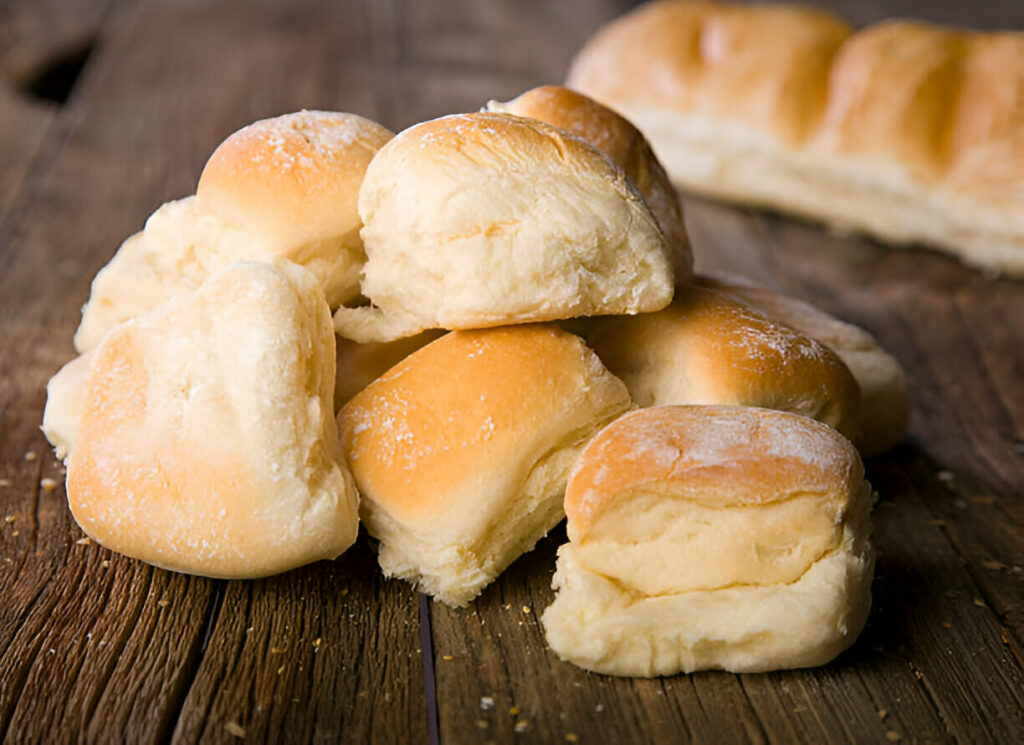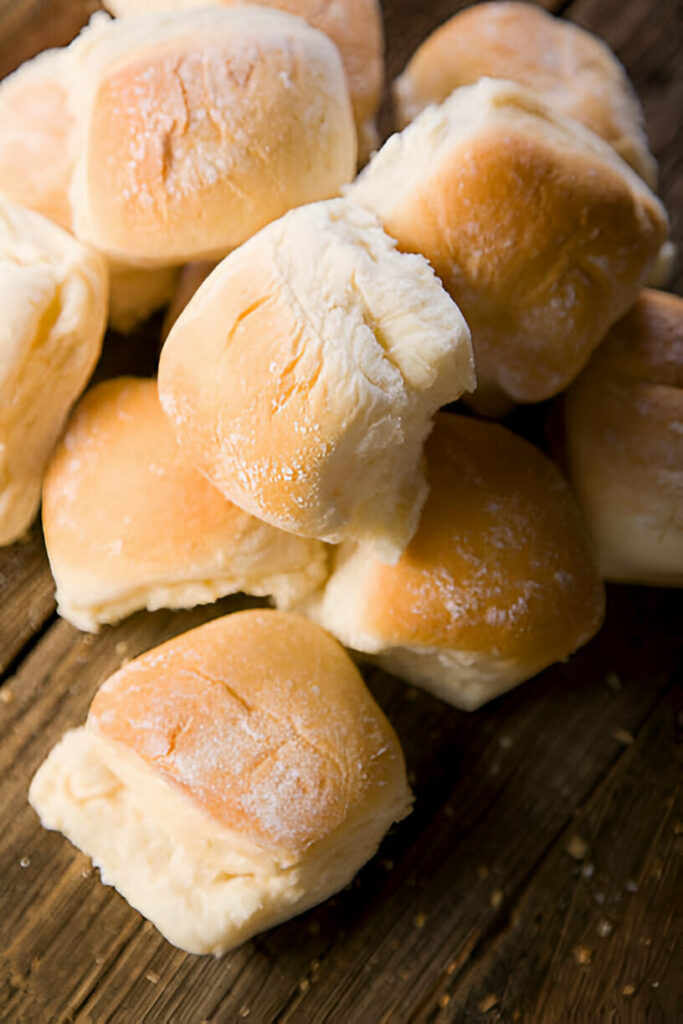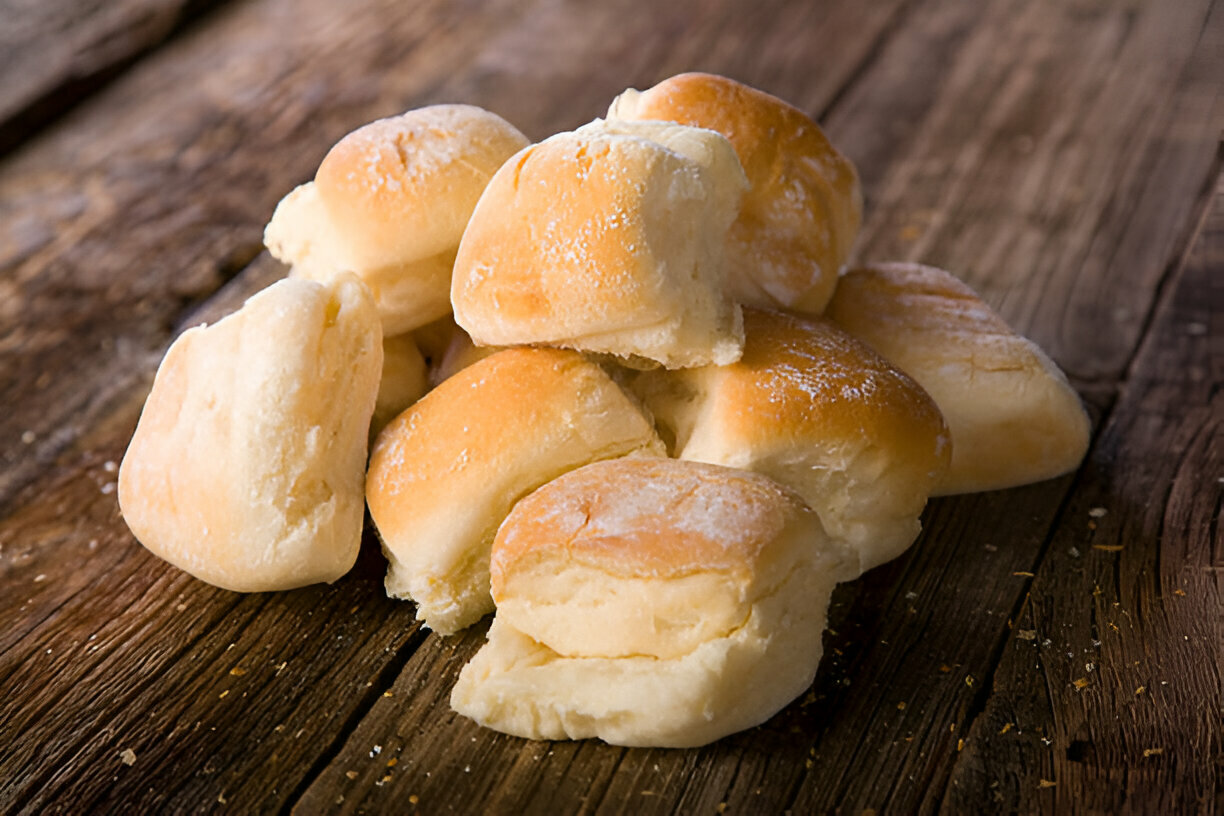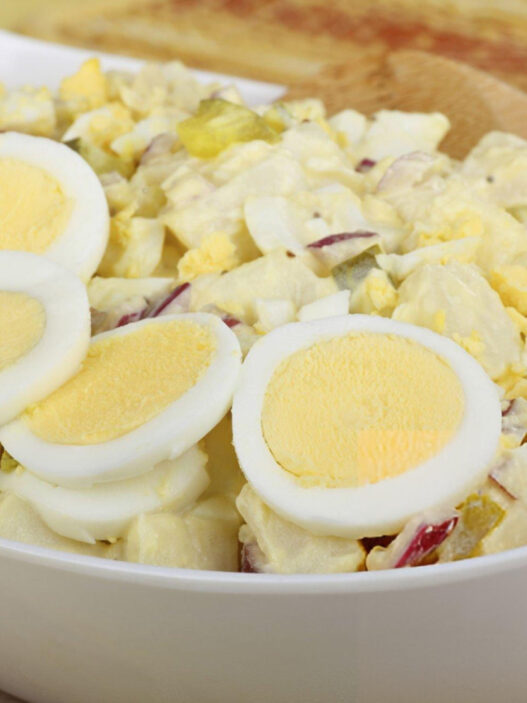Warm, fluffy, and perfectly golden, homemade French Bread Rolls bring a comforting charm to any table. Their soft interior and lightly crisp exterior make them irresistible, whether served fresh from the oven or tucked into a basket for later. Few things can rival the satisfaction of crafting these simple yet elegant rolls at home.

Ingredients Breakdown
Choosing the right flour is essential for achieving the ideal roll texture. All-purpose flour yields a lighter, softer crumb, making it perfect for rolls that are tender yet sturdy enough for sandwiches. Bread flour, on the other hand, has a higher protein content, which lends more chew and structure. Either option works beautifully depending on whether you prefer a lighter or slightly heartier roll.
The yeast you select will influence the rise and flavor of the rolls. Instant yeast activates quickly and integrates easily into the dough without needing to proof separately. Active dry yeast requires a short activation period in warm water but can yield slightly more complex, yeasty undertones in the finished rolls.
Sweeteners like granulated sugar or honey do more than add a hint of sweetness. They feed the yeast during fermentation, promoting a faster, more robust rise. Honey, in particular, imparts a subtle floral note that adds depth to the dough’s flavor profile.
The oil in the dough plays a crucial role in tenderizing the crumb. Canola, vegetable, or olive oil can be used interchangeably, though neutral-flavored oils keep the flavor pure and allow the bread’s natural notes to shine. Olive oil offers a richer, more Mediterranean character if preferred.
Salt and water may seem secondary, but they are the quiet heroes of any dough. Salt strengthens the gluten network and enhances flavor, while warm water activates the yeast and binds all the ingredients together into a supple, workable dough.
Step-by-Step Preparation Guide
Mixing the dough properly from the start ensures a smooth, cohesive texture. Begin by combining the warm water, yeast, sugar, oil, salt, and an initial portion of the flour. Gradually incorporate the remaining flour until a soft, slightly sticky dough forms, cleaning the sides of the bowl as you mix.
Proper kneading transforms the dough from a rough mass into a smooth, elastic ball. Whether using a stand mixer or working by hand, knead until the dough feels supple and slightly tacky but not sticky. A good dough should stretch easily without tearing and spring back lightly when pressed.
The first rise is where the magic begins. Placing the dough in a lightly greased bowl and covering it allows it to rise undisturbed, ideally doubling in volume over the course of 1–2 hours. A warm, draft-free environment encourages consistent fermentation and a light, airy texture.
Shaping the rolls requires a gentle hand. After deflating the risen dough, divide it evenly into portions. Form each piece into a smooth ball by tucking the seams underneath, ensuring a taut surface that promotes an even, rounded rise during baking.
Proper proofing is essential to achieving a lofty, tender roll. Place the dough balls close enough to allow them to rise and touch slightly, but not overcrowd. Cover loosely with greased plastic wrap to protect the surface without compressing the delicate structure. Allow them to puff up visibly, doubling once again.
Baking at a high temperature ensures a beautifully golden exterior while locking in moisture for a soft interior. Watch for visual cues: rolls should be lightly browned and sound hollow when tapped on the bottom.
Brushing the warm rolls with melted butter immediately after baking adds a rich, glossy finish. This final touch not only enhances flavor but also keeps the crust soft and inviting.

Recipe Tips & Frequently Asked Questions
How to achieve a light and airy crumb
Use the minimum amount of flour necessary to form a cohesive dough, and allow full, proper rises without rushing the proofing stages.
Adjusting flour quantity based on dough texture
Start with less flour and gradually add more only if the dough remains excessively sticky; aim for a slightly tacky but manageable feel.
How to fix dough that’s too sticky or too dry
If too sticky, add flour a tablespoon at a time; if too dry, sprinkle with a bit of warm water and knead until smooth.
Tricks to keep rolls soft after baking
Cover the warm rolls lightly with a clean kitchen towel to trap steam and maintain a tender crust.
Can I make the dough ahead and refrigerate it?
Yes, after the first rise, punch it down, cover tightly, and refrigerate overnight. Let it come to room temperature before shaping and baking.
How do I freeze the rolls for later use?
Bake, cool completely, and freeze in airtight bags. Reheat in the oven at 350°F until warmed through.
Can I double the recipe for a larger batch?
Absolutely. Double all ingredients proportionally and divide the dough into two pans or bake in batches.
What can I do if my dough isn’t rising properly?
Ensure your yeast is fresh and the water was warm (not hot). Place the dough in a warmer environment or allow additional rising time.
What to Serve With This Recipe
French Bread Rolls shine alongside hearty soups like creamy tomato basil, rich beef stew, or rustic chicken noodle. Their soft, pillowy texture makes them perfect for soaking up broths and sauces without falling apart.
Transform them into sandwich rolls by slicing and stuffing with deli meats, cheeses, or roasted vegetables. Their structure holds fillings well without becoming soggy.
For breakfast or brunch, serve them warm with flavored butters, fruit preserves, or even a light drizzle of honey. Their gentle sweetness pairs beautifully with both sweet and savory spreads.
Creative Variations
Incorporate finely chopped fresh herbs like rosemary, thyme, or chives into the dough for an aromatic twist. Adding a handful of grated cheese, such as cheddar or parmesan, into the dough brings a savory depth and beautiful speckled crumb.
Miniature dinner rolls can be shaped from smaller portions of dough, creating bite-sized versions ideal for parties. Alternatively, form larger portions for oversized sandwich buns perfect for burgers or hearty fillings.
For a nuttier, earthier flavor, substitute half of the all-purpose flour with whole wheat flour. This variation produces a slightly denser but deeply satisfying roll that pairs wonderfully with robust meals.
Homemade French Bread Rolls are a true testament to the simple pleasures of baking. Soft, fluffy, and beautifully golden, they fit effortlessly into any meal, from cozy family dinners to elegant holiday spreads. With just a few staple ingredients and a little care, these rolls become a cherished addition to any table, offering the warm satisfaction that only fresh-baked bread can deliver.

Ingredients
1 teaspoon Salt
2 tablespoons Canola oil, vegetable oil, or other neutral-flavored oil (olive oil can also be used)
1 tablespoon Instant or active dry yeast (see note)
2 tablespoons Granulated sugar or honey
1 ½ cups Warm water
3 ½ to 4 cups (497 to 569 g) All-purpose or bread flour, more or less (see note)
Instructions
In the bowl of a stand mixer fitted with a dough hook, or in a large bowl if mixing by hand, combine the warm water, yeast, sugar, oil, salt, and 2 cups of the flour. Begin mixing the ingredients together, then gradually add the remaining flour, a little at a time, until the dough pulls cleanly away from the sides of the bowl.
Continue kneading the dough for 4–5 minutes in the stand mixer or 7–9 minutes by hand. The dough should develop into a soft, pliable mass that feels smooth but still retains a slight tackiness. Pause kneading after a few minutes to pinch off a small portion of dough; it should roll into a ball with minimal sticking. If the dough clings excessively to your fingers, sprinkle in a bit more flour as needed.
Transfer the dough to a lightly greased bowl, turning it once to coat the surface, and cover it loosely. Allow the dough to rise in a warm, draft-free place until it has doubled in size, approximately 1–2 hours.
Gently deflate the dough and tip it onto a lightly greased work surface. Divide it into 12 equal portions, aiming for about 2.75 ounces per piece. Shape each piece into a smooth ball, ensuring the seams are tucked underneath.
Arrange the dough balls in a lightly greased 9×13-inch baking dish or on a large, rimmed baking sheet lined with parchment paper or lightly oiled. Space the rolls about ½ to 1 inch apart to allow room for expansion during proofing.
Cover the rolls loosely with lightly greased plastic wrap, allowing the wrap to drape over the sides without anchoring it beneath the tray. This prevents the rolls from being compressed as they rise. Let the rolls proof until noticeably puffy and doubled in size, about 45 minutes to 1 hour.
Meanwhile, preheat the oven to 400°F (200°C). Bake the rolls for 15–17 minutes, or until they are evenly golden brown and fully baked through.
As soon as the rolls come out of the oven, brush their tops generously with melted butter to add a rich, glossy finish. Allow to cool slightly before serving warm.

French Bread Rolls Recipe
Ingredients
- 1 teaspoon Salt
- 2 tablespoons Canola oil vegetable oil, or other neutral-flavored oil (olive oil can also be used)
- 1 tablespoon Instant or active dry yeast see note
- 2 tablespoons Granulated sugar or honey
- 1 ½ cups Warm water
- 3 ½ to 4 cups 497 to 569 g All-purpose or bread flour, more or less (see note)
Instructions
- In the bowl of a stand mixer fitted with a dough hook, or in a large bowl if mixing by hand, combine the warm water, yeast, sugar, oil, salt, and 2 cups of the flour. Begin mixing the ingredients together, then gradually add the remaining flour, a little at a time, until the dough pulls cleanly away from the sides of the bowl.
- Continue kneading the dough for 4–5 minutes in the stand mixer or 7–9 minutes by hand. The dough should develop into a soft, pliable mass that feels smooth but still retains a slight tackiness. Pause kneading after a few minutes to pinch off a small portion of dough; it should roll into a ball with minimal sticking. If the dough clings excessively to your fingers, sprinkle in a bit more flour as needed.
- Transfer the dough to a lightly greased bowl, turning it once to coat the surface, and cover it loosely. Allow the dough to rise in a warm, draft-free place until it has doubled in size, approximately 1–2 hours.
- Gently deflate the dough and tip it onto a lightly greased work surface. Divide it into 12 equal portions, aiming for about 2.75 ounces per piece. Shape each piece into a smooth ball, ensuring the seams are tucked underneath.
- Arrange the dough balls in a lightly greased 9×13-inch baking dish or on a large, rimmed baking sheet lined with parchment paper or lightly oiled. Space the rolls about ½ to 1 inch apart to allow room for expansion during proofing.
- Cover the rolls loosely with lightly greased plastic wrap, allowing the wrap to drape over the sides without anchoring it beneath the tray. This prevents the rolls from being compressed as they rise. Let the rolls proof until noticeably puffy and doubled in size, about 45 minutes to 1 hour.
- Meanwhile, preheat the oven to 400°F (200°C). Bake the rolls for 15–17 minutes, or until they are evenly golden brown and fully baked through.
- As soon as the rolls come out of the oven, brush their tops generously with melted butter to add a rich, glossy finish. Allow to cool slightly before serving warm.
Notes
-
Yeast:
- Originally, active dry yeast needed to be dissolved in water first, but today it’s formulated with smaller particles and can be mixed directly into the dough.
- Use 1 tablespoon of yeast if measuring from a bulk package.
- If using yeast packets (each packet contains 2 ¼ teaspoons), one packet is enough for this recipe.
- If using a packet instead of a full tablespoon, expect the dough to take slightly longer to rise.
-
Tips:
- Avoid over-flouring or under-flouring the dough to maintain the perfect texture.
- Follow the guidance given in the recipe for flour adjustments.
- A simple yeast tutorial is available for extra help, and the step-by-step photos below the recipe provide helpful visual cues.
-
Tutorial for Shaping Rolls:
- To achieve evenly shaped, round rolls, refer to the video tutorial (at minute marker 2:20).
-
Whole Wheat Version:
- For a fully whole wheat option, try the fluffy whole wheat French bread roll recipe.
- Alternatively, substitute part of the all-purpose flour with whole wheat flour in this recipe for a heartier roll.
-
Freezable Option:
- These rolls freeze beautifully once baked and cooled.
- Place them in a zipper-lock freezer bag and store them in the freezer.
- To reheat, either let them thaw at room temperature for a few hours or microwave from frozen for 2–3 minutes at 70% power.


















